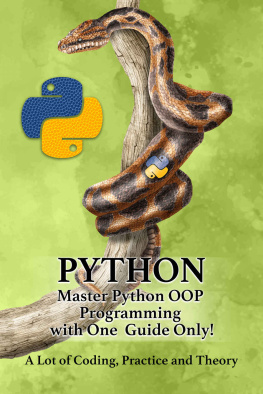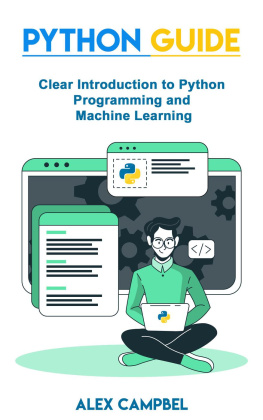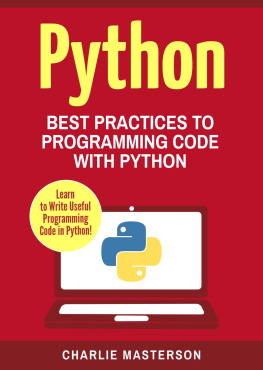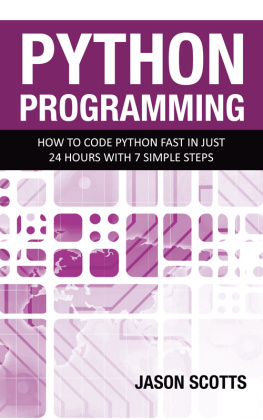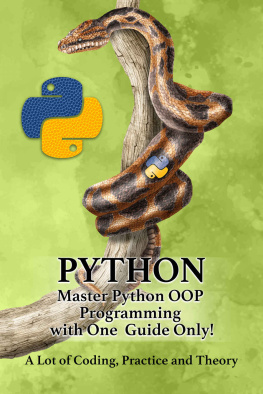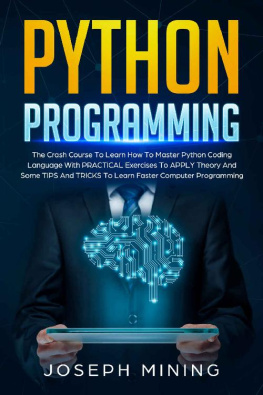Sekuloski - PYTHON – Master Python OOP Programming with One Guide Only! A lot of Coding, Practice and Theory Learn Python with Hands-On Projects
Here you can read online Sekuloski - PYTHON – Master Python OOP Programming with One Guide Only! A lot of Coding, Practice and Theory Learn Python with Hands-On Projects full text of the book (entire story) in english for free. Download pdf and epub, get meaning, cover and reviews about this ebook. year: 2022, genre: Computer. Description of the work, (preface) as well as reviews are available. Best literature library LitArk.com created for fans of good reading and offers a wide selection of genres:
Romance novel
Science fiction
Adventure
Detective
Science
History
Home and family
Prose
Art
Politics
Computer
Non-fiction
Religion
Business
Children
Humor
Choose a favorite category and find really read worthwhile books. Enjoy immersion in the world of imagination, feel the emotions of the characters or learn something new for yourself, make an fascinating discovery.
PYTHON – Master Python OOP Programming with One Guide Only! A lot of Coding, Practice and Theory Learn Python with Hands-On Projects: summary, description and annotation
We offer to read an annotation, description, summary or preface (depends on what the author of the book "PYTHON – Master Python OOP Programming with One Guide Only! A lot of Coding, Practice and Theory Learn Python with Hands-On Projects" wrote himself). If you haven't found the necessary information about the book — write in the comments, we will try to find it.
Sekuloski: author's other books
Who wrote PYTHON – Master Python OOP Programming with One Guide Only! A lot of Coding, Practice and Theory Learn Python with Hands-On Projects? Find out the surname, the name of the author of the book and a list of all author's works by series.
PYTHON – Master Python OOP Programming with One Guide Only! A lot of Coding, Practice and Theory Learn Python with Hands-On Projects — read online for free the complete book (whole text) full work
Below is the text of the book, divided by pages. System saving the place of the last page read, allows you to conveniently read the book "PYTHON – Master Python OOP Programming with One Guide Only! A lot of Coding, Practice and Theory Learn Python with Hands-On Projects" online for free, without having to search again every time where you left off. Put a bookmark, and you can go to the page where you finished reading at any time.
Font size:
Interval:
Bookmark:
PYTHON Master Python OOP Programming with One Guide Only !
A lot of Coding, Practice, and Theory
Learn Python with Hands-On Projects
Rick Sekulsoki
Copyright 2022 Rick Sekuloski
All rights reserved.
ISBN:
Preface
This book is a perfect guide for someone that wants to learn Python. You will find that this book explains complex concepts in an easy-to-understand manner. After covering the basics, we will shift our focus to some intermediate features that every Python programmer should know. Im not a professional writer but Im a professional web developer and programmer, therefore my goal is to teach you programming through perfect examples and clean and executable code. When I first started learning Python, I was afraid of how hard this language could be, but I can assure you that Python, like any other programming language, only requires patience, practice, and of course a good guide with practical examples. The goal of my book is to help you bring your current skills to a professional level. If you are looking for additional reference materials then I can only suggest the Python documentation. If you have already looked at the Python documentation then you know it can be long, scary, and overwhelming. Do not worry because this book will save you months of researching, planning, and sleepless nights.
You can visit Pythons official websites by clicking on following link:
https://docs.python.org/3/
I would also like to hear from you. If you need to contact me, please reach out through any of my social media accounts, and please consider leaving a review with your comment.
My social media accounts:
- Twitter: https://twitter.com/Rick29702077?s=09
- LinkedIn: https://www.linkedin.com/in/rick-sekuloski
- Facebook: https://www.facebook.com/theodorecodingwebdevelopment/
- YouTube: https://www.youtube.com/channel/UCQanUcCNaBg-IM-k0u8z0oQ
Who is this book for?
This book is for:
Beginners If you are a beginner, this book will definitely help you to learn Python
Teachers/Educators Are you someone that teaches Python? Then this book is an organized guide that will help you and your students learn the new concepts through practical examples and theory
Developers Are you a developer but need to refresh your memory? This is the best reference guide you will find
Anyone - that is seeking to gain a deep understanding of the Python language
How to Get the most out of this book?
To get the most out of this book, you will need the following tools:
Access to internet
Any of the following: Computer, Laptop, tablet, phone, or an eBook Reader (kindle)
An up-to-date browser such as Google Chrome, Firefox, Edge, or Safari
I will use a combination of code editors and IDEs, but you can decide which tool is the most suitable for your needs
If you are using an e-reader to read this book, then please sit back, get comfortable, and enjoy because I will explain every step and include the code and screenshots. But if you like to go through the examples and try to run the code, then please use a computer or laptop. The book will be divided into chapters, and in each chapter will be a new theory coupled with examples, output, and screenshots. The first few chapters are easy but at the same time, they are the most important ones.
Download The files
You can download the entire code by visiting my GitHub ( source code management system ) repository page using the following link:
https://github.com/RickSekuloski/python_book1
There you will find all the materials (code examples and exercises) that I will use in this book.
Once the file is downloaded to your computer, you will need to unzip the content. Please don't try to open or run the code while it's inside the zipped folders/directories. Ensure you extract the folder into your desired destination, such as the desktop.
You can Unzip the files using the following programs:
WinRAR/7-Zip for Windows
Zipeg/iZip/UnRarX for Mac
7-Zip/PeaZip for Linux
Welcome to the first chapter. This chapter is by far the most important one. Here, the idea is to try to understand the basic Python features because without them you will have a hard time understanding the concepts in the following chapters where more intermediate features will be introduced. In this chapter, we will start by covering the basics of Python, like what Python is and how we can run Python code. Although it is called Python basics, there will be some features that are not that simple to understand, therefore, please make sure you spend enough time learning the concepts before moving to the next section.
What is Python?
According to official documentation, Python is An interpreted, object-oriented, high-level programming language with dynamic semantics. Python is a general computer programming language, meaning it can be used to create applications that will solve different problems. Python can be used to create websites, software, or to even perform data analysis. Learning Python is simple because it uses simple syntax, therefore, even people that are new to programming can learn it. Python emphasizes code readability and this can be achieved because Python supports modules and packages. In simple words, this means that instead of having one large file with thousands of lines of code, we can have multiple files that can communicate and share the code with the main file. This reduces the program maintenance cost and because Python is free to use, it is a perfect programming language. The Python programming language was created by Guido ban Rossum and it was first released on February 20, 1991.
Why is Python so popular?
Python is a widely used high-level programming language because the code is written in an English-like format or if you look at the code closely, you will see that is written similarly to the way humans think. Some may argue that Python is slower than other high-level languages like C , C++, or Java but this does not affect the end users. Another big advantage is that Python is more productive compared to Java and C++ because building an application takes less time, effort, and fewer lines of code. Because of its popularity, the Python community is exceptional and large. Having a large community is very important because Python allows us to create packages and modules that can be shared with the rest of the developers. This makes Python a flexible language with different real-world applications like:
- Games development
- Web Development
- AI and Machine learning
- E-commerce
- Image processing and graphic design
- Scientific computing
Another benefit is that the Python code is interpreted, not compiled. This means that the code is interpreted line by line during the runtime and doesnt require pre-runtime compilation. Because the Python code uses an Interpreter, it executes the statements line by line and its easier to debug and spot the errors. There are third-party tools that can be used to optimize the performance and to also to handle errors. One huge benefit is that Python code is portable and cross-platform functionality is a must in todays development. This means that applications created in Python can run on any operating system like Windows, macOS, Linus, and Unix without modifications. These are some of the features that make Python one of the most popular programming languages.
Python Interpreter
As we know from the definition, Python is an interpreted high - level language. This means Python needs an interpreter to read the code from our file and execute the instructions from that file. Other high-level languages like C++ require us to compile the code. The compilation process will turn the code that is humanly understandable into a code that only machines can understand called Machine code . The machine code consists of basic-level instructions that are executed by the CPU . After the compilation process, an executable file is generated. On the other hand, Python is an interpreted language, meaning it will not translate the code into machine code but will translate it into bytecode which will create a file with an extension (. pyc ). The Python interpreter comes when we install Python and we will see how this is done in chapter 3. This means when we install the official Python language, we have access to the Python interpreter as well. In short, the Python interpreter is a program that will read our source code and run it for us. So, what is the difference between the bytecode file and the compilation file ? Well, the compilation file is a set of instructions that are executed on the CPU and the bytecode file instructions are executed on a Virtual Machine known as CPython VM . Because of this (CPython VM), the bytecode can be executed on any operating system or platform. In simple words, a developer writes the code in Python and then the code is compiled into Python bytecode . This will create a file with an extension (. pyc ) and the bytecode is something that we as developers cant control because it happens in the background. So, the bytecode is a low-level representation of the code we write. The VM ( Python Virtual Machine ) is something we should not worry about as well because it is part of the Python system and is used to run our Python files/scripts. What is interesting is that the Python Interpreter is written and implemented as a C program and that is why its called CPython . Here is the figure that explains the whole process of how the Interpreter works:
Font size:
Interval:
Bookmark:
Similar books «PYTHON – Master Python OOP Programming with One Guide Only! A lot of Coding, Practice and Theory Learn Python with Hands-On Projects»
Look at similar books to PYTHON – Master Python OOP Programming with One Guide Only! A lot of Coding, Practice and Theory Learn Python with Hands-On Projects. We have selected literature similar in name and meaning in the hope of providing readers with more options to find new, interesting, not yet read works.
Discussion, reviews of the book PYTHON – Master Python OOP Programming with One Guide Only! A lot of Coding, Practice and Theory Learn Python with Hands-On Projects and just readers' own opinions. Leave your comments, write what you think about the work, its meaning or the main characters. Specify what exactly you liked and what you didn't like, and why you think so.

